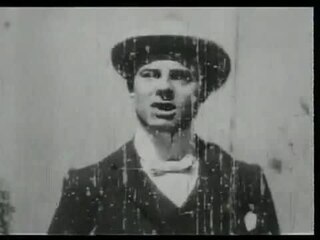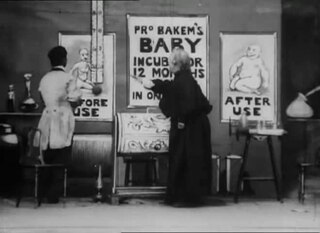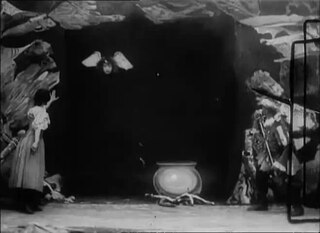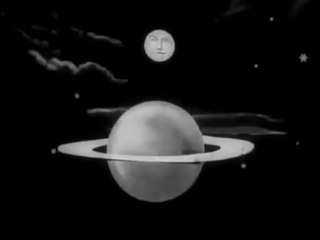Related Research Articles

The Kiss in the Tunnel, also known as A Kiss in the Tunnel, is a 1899 film British short silent comedy film, produced and directed by George Albert Smith, showing a couple sharing a brief kiss as their train passes through a tunnel, which is said to mark the beginnings of narrative editing. The film is the first to feature Laura Bayley, Smith's wife.
The Torre del Bierzo rail disaster occurred on 3 January 1944 near the village of Torre del Bierzo in the El Bierzo region of Spain's León province when three trains collided and caught fire inside a tunnel. Although the official death toll was 78, and at the time it was estimated to be 200–250, the most recent study has estimated it at no more than 100.

The Big Swallow is a 1901 British silent comic trick film, directed by James Williamson, featuring a man, irritated by the presence of a photographer, who solves his dilemma by swallowing him and his camera whole. The three-shot trick film is, according to Michael Brooke of BFI Screenonline, "one of the most important early British films in that it was one of the first to deliberately exploit the contrast between the eye of the camera and of the audience watching the final film".

Our New Errand Boy is a 1905 British short silent comedy film, directed by James Williamson, about a new errand boy, engaged by a grocer who soon regrets the appointment. This "relatively unambitious" chase comedy, according to Michael Brooke of BFI Screenonline, "is one of a number of Williamson films featuring a mischievous child, played by the director's son Tom". "Although essentially a series of sketches", this film, according to David Fisher, "demonstrates the extent to which Williamson had developed film technique For a start, the film has a title frame, which includes the logo of the Williamson Cinematograph Company", and, "the chase section anticipates the American comedies of the next decade".

Walter Robert Booth was a British magician and early pioneer of British film. Collaborating with Robert W. Paul and then Charles Urban mostly on "trick" films, he pioneered techniques that led to what has been described as the first British animated film, The Hand of the Artist (1906). Booth is also notable for making the earliest film adaptation of A Christmas Carol with the silent film Scrooge, or, Marley's Ghost (1901).

An Over-Incubated Baby is a 1901 British silent comic trick film, directed by Walter R. Booth, featuring a woman who gets an unpleasant surprise after placing her baby in Professor Bakem's baby incubator for 12 months growth in one hour. The film is, "one of the most original of the trick films made by W.R. Booth and R.W. Paul in 1901." According to Michael Brooke of BFI Screenonline, "one of the less elaborate films made by Booth and Paul that year, though the concept itself is so imaginative that it arguably didn't need any more than basic jump-cut transformations."

The Countryman and the Cinematograph is a 1901 British short silent comedy film, directed by Robert W. Paul, featuring a stereotypical yokel reacting to films projected onto a screen. The film "is one of the earliest known examples of a film within a film", where, according to Michael Brooke of BFI Screenonline, "the audience reaction to that film is as important a part of the drama as the content of the film itself".

The Magic Sword; or, A Medieval Mystery is a 1901 British silent fantasy trick film, directed by Walter R. Booth, featuring a mediaeval knight battling to save a damsel from an ogre and a witch. The film, "is impressively elaborate, with single shots containing multiple trick effects achieved through complex double exposures and superimpositions," and according to Michael Brooke of BFI Screenonline, "was so startling that it moved the legendary stage illusionist J.N. Maskelyne to describe The Magic Sword as the finest trick film made up to then."

The '?' Motorist is a 1906 British silent comedy trick film, commonly called "The Mad Motorist" or "Questionmark Motorist" and directed by Walter R. Booth. Released in October 1906, the trick film is "one of the last films that W.R. Booth made for the producer-inventor R.W. Paul," and, according to Michael Brooke of BFI Screenonline, "looks forward to the more elaborate fantasies that Booth would make for Charles Urban between 1907 and 1911, as well as drawing on a wide range of the visual tricks that Booth had developed over the preceding half-decade."

Is Spiritualism a Fraud? is a 1906 British silent trick film directed by Walter R. Booth, featuring a medium exposed as a fake during a séance.

The Automatic Motorist is a 1911 British silent comic trick film, directed by Walter R. Booth, featuring a robot chauffeur taking an inventor and a young honeymooning couple on a wild ride around the planets and under the sea. The trick film is a "virtual remake of The '?' Motorist (1906)," according to Michael Brooke of BFI Screenonline, "but on a bigger scale."

Willie's Magic Wand is a 1907 British silent comic trick film, directed by Walter R. Booth, featuring a young boy terrorising the household with his father's magic wand.
Phantom rides or panoramas were an early genre of film popular in Britain and the US at the end of the 19th century. Pre-dating true narrative, the films simply show the progress of a vehicle moving forwards, usually shot by strapping a cameraman to the front. The term phantom ride was applied because the position of the camera meant that only the track and scenery could be seen and the movement appeared to be coming from an invisible force. Though many early films showed local tracks the demand for new footage led to more exotic locations being filmed. This brought a new dimension to the genre, showing foreign lands to those who would otherwise never see them. The genre is also significant, despite its short-lived popularity, due to the role it played in the development of the tracking shot, longer films and film editing, as well as its re-emergence in 4D film and simulation.

The Signalman is a 1976 BBC television adaptation of "The Signal-Man", an 1866 short story by Charles Dickens. The story was adapted by Andrew Davies as the BBC's sixth A Ghost Story for Christmas, with Denholm Elliott starring as the signalman and Bernard Lloyd as the traveller, an unnamed character who acts as a plot device in place of the short story's narrator.
References
- ↑ Christie, Ian (2005). Abel, Richard (ed.). Encyclopedia of Early Cinema. Taylor & Francis. p. 510. ISBN 9780415234405.
- ↑ Barnes, John (1997). The Beginnings of the Cinema in England, 1894–1901. University of Exeter Press. p. 12. ISBN 9780859895224.
- 1 2 Paul, Robert W. (1967). "Kinematographic Experiences". In Fielding, Raymond (ed.). A Technological History of Motion Pictures and television . University of California Press. p. 46.
- 1 2 3 Talbot, Frederick A. (1912). Moving Pictures: How They are Made and Worked. J. B. Lippincott Company. p. 205.
- 1 2 Brooke, Michael. "A Railway Collision". BFI Screenonline Database. Archived from the original on 25 May 2011. Retrieved 24 April 2011.
- ↑ Sears, Roger (2003). Making pictures: a century of European cinematography. Aurum. p. 30. ISBN 9780810943858.